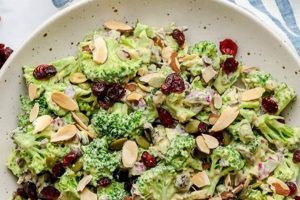A low-carbohydrate adaptation of a classic side dish, this type of salad typically features broccoli, a creamy dressing, and other ingredients compliant with the ketogenic diet. Examples of such ingredients include bacon, cheese, sunflower seeds, and a mayonnaise-based dressing often seasoned with vinegar, sweeteners like erythritol or stevia, and spices. Variations can incorporate other low-carb vegetables like cauliflower or red onion.
This dish offers a palatable way to increase vegetable consumption while adhering to the macronutrient restrictions of the ketogenic diet. Cruciferous vegetables like broccoli provide essential vitamins, minerals, and fiber. Adapting traditional recipes to fit ketogenic guidelines can contribute to dietary variety and satisfaction, promoting long-term adherence to the diet. Historically, the popularity of such adaptations has grown alongside the increasing adoption of ketogenic and low-carb lifestyles for weight management and other health goals.
The following sections will delve into specific recipe variations, offer nutritional information, and provide practical tips for preparing and enjoying this dish.
Tips for Crafting the Perfect Keto Broccoli Salad
Creating a delicious and satisfying keto-friendly broccoli salad requires attention to detail and ingredient selection. These tips offer guidance for optimal results.
Tip 1: Blanch the Broccoli: Briefly submerging broccoli florets in boiling water, followed by an ice bath, ensures a vibrant green color and a tender-crisp texture. Overcooking can lead to a mushy consistency.
Tip 2: Choose High-Quality Fats: Opt for full-fat mayonnaise, preferably made with avocado or olive oil, and consider incorporating healthy fats like chopped almonds or sunflower seeds.
Tip 3: Balance Sweetness and Acidity: Achieve a well-rounded flavor profile by balancing the sweetness of any added keto-friendly sweetener with the tanginess of vinegar, such as apple cider or red wine vinegar.
Tip 4: Customize with Low-Carb Additions: Enhance flavor and texture with ingredients like crumbled bacon, shredded cheddar cheese, chopped red onion, or roasted pumpkin seeds. Ensure all additions align with ketogenic dietary guidelines.
Tip 5: Proper Storage: Store the salad in an airtight container in the refrigerator. Consume within three to four days for optimal freshness and flavor.
Tip 6: Consider Raw Broccoli for Added Crunch: For a different textural experience, incorporate some raw broccoli florets alongside blanched ones.
Tip 7: Taste and Adjust: Before serving, taste the salad and adjust seasonings as needed. This allows for personalized flavor preferences.
By following these tips, one can create a flavorful, visually appealing, and nutritionally sound broccoli salad that complements a ketogenic lifestyle.
With a foundation in these fundamental principles, further exploration of recipe variations and advanced techniques can enhance culinary expertise.
1. Low-Carb Vegetables
Low-carbohydrate vegetables play a crucial role in ketogenic diets, providing essential nutrients and fiber without significantly impacting blood sugar levels. In the context of a keto-friendly broccoli salad, these vegetables form the foundation of the dish. Broccoli, the star ingredient, offers a substantial dose of vitamins, minerals, and antioxidants. Other low-carb vegetables, such as cauliflower, bell peppers (specifically green), and leafy greens like spinach or kale, can be incorporated to diversify flavor and nutrient profiles. The selection of these vegetables directly impacts the overall carbohydrate count of the salad, ensuring it aligns with ketogenic principles.
The importance of choosing low-carb vegetables extends beyond simply adhering to dietary restrictions. These vegetables offer bulk and satiety, contributing to a feeling of fullness and potentially aiding in appetite control. This can be particularly beneficial within a ketogenic diet, which often restricts calorie-dense options. For example, substituting higher-carb vegetables like carrots or peas with broccoli and cauliflower significantly reduces the net carbohydrate content while maintaining a satisfying volume. Furthermore, the variety of textures and flavors available within low-carb vegetables allows for diverse culinary experiences, preventing meal monotony, a common challenge in restrictive diets. Adding chopped raw spinach offers a contrasting texture to blanched broccoli, while slivered bell peppers introduce a subtle sweetness.
Prioritizing low-carb vegetables in a keto-friendly broccoli salad is paramount for achieving both nutritional adequacy and dietary adherence. Their strategic incorporation not only maintains compliance with ketogenic macronutrient ratios but also enhances the culinary appeal of the dish. Understanding the role and benefits of these vegetables empowers individuals to create flavorful and satisfying meals within the constraints of a ketogenic lifestyle. This knowledge facilitates informed choices that support both short-term and long-term health goals. Addressing potential challenges like nutrient deficiencies requires careful planning and diversification of vegetable choices within keto-compliant options.
2. Healthy Fats
Healthy fats are integral to a ketogenic diet and play a crucial role in a successful broccoli salad recipe tailored to this dietary approach. The ketogenic diet drastically restricts carbohydrate intake, forcing the body to shift its primary fuel source from glucose to fats, a metabolic state known as ketosis. Incorporating sufficient healthy fats is essential for providing the body with the necessary energy and supporting various physiological functions within this metabolic shift. Within a keto broccoli salad, healthy fats contribute not only to macronutrient balance but also to flavor, texture, and satiety. Examples include mayonnaise (made with avocado or olive oil), avocado oil itself as part of the dressing, and additions like chopped almonds, sunflower seeds, or crumbled bacon.
The absence of sufficient healthy fats in a ketogenic diet can lead to suboptimal energy levels, difficulty maintaining ketosis, and potential nutrient deficiencies. In the specific case of a keto broccoli salad, insufficient fat content can result in a bland and less satisfying dish. For example, using a low-fat or fat-free mayonnaise alternative can negatively impact both the flavor profile and the overall efficacy of the salad within a ketogenic meal plan. The inclusion of healthy fats also aids in the absorption of fat-soluble vitamins present in the broccoli and other salad components. Furthermore, the richness and creamy texture provided by healthy fats contribute to the palatability of the salad, making it a more enjoyable and sustainable component of a long-term ketogenic dietary plan.
In conclusion, the strategic incorporation of healthy fats in a keto broccoli salad is essential for achieving both nutritional adequacy and culinary satisfaction. Understanding the critical role of these fats within the broader context of a ketogenic diet ensures that the salad serves its intended purposeproviding a flavorful, satiating, and keto-compliant meal component. Successfully integrating healthy fats into this dish not only optimizes its macronutrient profile but also enhances its sensory appeal, promoting adherence to a ketogenic lifestyle. Careful selection of fat sources, considering both their nutritional value and their impact on the final dish, is paramount. Addressing potential nutritional deficiencies through the inclusion of diverse healthy fat sources within the salad contributes to the overall success of a ketogenic dietary pattern.
3. Keto-Friendly Sweetener
Keto-friendly sweeteners play a nuanced role in keto broccoli salad recipes. The ketogenic diet, characterized by its extremely low carbohydrate intake, necessitates the replacement of conventional sugars with alternatives that minimally impact blood glucose levels. In a broccoli salad, a touch of sweetness can balance the savory and sometimes acidic elements commonly found in keto-friendly dressings, like vinegar and spices. Sweeteners contribute to a more palatable and well-rounded flavor profile, crucial for long-term adherence to often restrictive dietary regimens. Examples of suitable sweeteners include erythritol, stevia, and monk fruit, each offering distinct flavor profiles and levels of sweetness.
The judicious use of keto-friendly sweeteners contributes significantly to the overall success of a keto broccoli salad. Over-sweetening can mask the natural flavors of the vegetables and other ingredients, while insufficient sweetness can result in a bland or overly tart dish. For instance, a broccoli salad dressing featuring apple cider vinegar may benefit from the addition of a small amount of erythritol to temper the vinegar’s sharpness. Furthermore, certain keto-friendly sweeteners, like erythritol, can contribute a pleasant cooling sensation, enhancing the overall sensory experience. The choice of sweetener and its quantity should be carefully considered in relation to the other ingredients and the desired flavor profile. Balancing sweetness with acidity and other savory components is essential for creating a harmonious and enjoyable dish.
Appropriate sweetener selection and application are crucial for optimizing a keto broccoli salad. Considerations include individual taste preferences, potential digestive sensitivities to certain sweeteners (such as erythritol’s potential laxative effect in larger quantities), and the sweetener’s impact on the recipe’s overall texture and stability. Careful consideration of these factors ensures the sweetener enhances rather than detracts from the final product. Successfully incorporating a keto-friendly sweetener contributes to both the palatability and the dietary compliance of the salad within a ketogenic meal plan, promoting long-term dietary adherence and satisfaction. This careful approach addresses the common challenge of balancing flavor and dietary restrictions within a ketogenic lifestyle.
4. Flavorful Additions
Flavorful additions constitute a critical component of a successful broccoli salad recipe adapted for the ketogenic diet. The restrictive nature of the ketogenic diet, with its emphasis on minimizing carbohydrate intake, often necessitates creative approaches to enhance the palatability of meals. Flavorful additions, strategically chosen to align with ketogenic principles, play a vital role in preventing meal monotony and promoting long-term dietary adherence. These additions contribute complexity, texture, and depth of flavor, transforming a simple broccoli salad into a satisfying and enjoyable dish. Ingredients such as bacon, cheese, nuts, seeds, and certain spices can elevate the salad’s sensory profile while remaining compliant with ketogenic macronutrient targets. For example, crumbled bacon provides a smoky, salty counterpoint to the broccoli’s slight bitterness, while shredded cheddar cheese adds a creamy richness.
The careful selection of flavorful additions directly impacts the nutritional value and overall success of a keto broccoli salad. Prioritizing nutrient-dense options like toasted sunflower seeds or slivered almonds not only contributes to flavor and texture but also provides healthy fats, essential in a ketogenic diet. Spices, such as red pepper flakes or garlic powder, introduce complexity without adding carbohydrates. However, the quantity and combination of these additions must be thoughtfully managed to avoid inadvertently increasing the carbohydrate content or disrupting the desired flavor balance. Incorporating too much cheese, for example, can overshadow the other flavors and create a heavy, less refreshing salad. Striking a balance between enhancing flavor and maintaining dietary adherence requires careful consideration of each ingredient’s nutritional composition and its impact on the overall sensory experience.
Incorporating flavorful additions into a keto broccoli salad presents an opportunity to elevate a simple dish into a culinary experience that supports both nutritional goals and enjoyment. Addressing potential challenges like excessive calorie consumption or unintended carbohydrate intake requires careful portion control and ingredient selection. Understanding the interplay between flavor, texture, and nutritional value empowers individuals to create a personalized keto broccoli salad that fosters long-term adherence to the diet. This careful approach addresses the complexities of maintaining a restrictive diet while maximizing both nutritional adequacy and culinary satisfaction.
5. Creamy Dressing
Creamy dressings are fundamental to keto broccoli salad, providing crucial flavor, texture, and satiety within the constraints of this dietary approach. The ketogenic diets emphasis on high fat and low carbohydrate intake necessitates dressings that align with these macronutrient targets while enhancing the palatability of typically low-carb vegetables like broccoli. The creamy texture not only contributes to a more satisfying sensory experience but also aids in binding the salad ingredients together. The following facets explore the critical aspects of a successful keto-friendly creamy dressing.
- Fat Sources
The foundation of any keto-friendly creamy dressing lies in its fat content. Healthy fats provide the necessary richness and satiety while adhering to ketogenic principles. Common choices include full-fat mayonnaise (ideally made with avocado or olive oil), sour cream, and Greek yogurt. Avocado oil or olive oil can also be incorporated to adjust consistency and enhance flavor. Selecting high-quality fat sources is crucial for both nutritional value and optimal flavor delivery. For example, using avocado oil mayonnaise adds a subtle, buttery flavor compared to traditional soybean oil-based mayonnaise.
- Flavor Balancing
Balancing flavors within a creamy dressing is essential for creating a delicious keto broccoli salad. The richness of the fat base provides a canvas for incorporating other flavor components. Acidity from vinegar (apple cider, red wine, or white wine vinegar), tanginess from lemon or lime juice, and savory notes from spices and herbs create a complex and well-rounded profile. Balancing these elements prevents the dressing from being overly rich or bland. For instance, the sharpness of Dijon mustard complements the creaminess of mayonnaise, while a touch of garlic powder adds depth.
- Keto-Friendly Sweeteners (Optional)
While not strictly necessary, small amounts of keto-friendly sweeteners can enhance the flavor profile of a creamy dressing, particularly when acidic components like vinegar are prominent. Sweeteners like erythritol, stevia, or monk fruit can balance the tartness and contribute to a more palatable salad. However, moderation is key, as excessive sweetness can mask the other flavors and compromise the dish’s overall balance. Careful consideration of the sweetener’s intensity and its interaction with other ingredients ensures a harmonious flavor profile.
- Texture and Consistency
Achieving the desired texture and consistency is crucial for a successful creamy dressing. The dressing should be thick enough to coat the broccoli and other salad components effectively but not so thick that it becomes heavy or gloppy. Adjusting the ratio of fat sources, such as mayonnaise and sour cream, or incorporating additional liquids like oil or lemon juice, allows for customization based on personal preference and the specific ingredients used in the salad. The texture significantly impacts the overall sensory experience of the dish.
The interplay of these facets contributes to the overall success of a keto broccoli salad, ensuring it aligns with dietary goals while delivering a satisfying and flavorful experience. The creamy dressing serves as the unifying element, binding the various components together and enhancing their individual characteristics. A well-executed creamy dressing elevates the salad from a simple combination of ingredients to a cohesive and enjoyable dish, supporting long-term adherence to a ketogenic lifestyle. Understanding the nuances of creating a flavorful and keto-compliant dressing is crucial for maximizing both the nutritional and sensory aspects of this dish.
6. Proper Preparation
Proper preparation techniques are essential for creating a successful keto broccoli salad. These techniques ensure optimal texture, flavor, and overall quality while adhering to the principles of a ketogenic diet. Careful attention to preparation details contributes significantly to the final dish’s palatability and nutritional value. The following facets highlight key considerations within proper preparation.
- Broccoli Handling
Proper handling of broccoli significantly impacts the final salad’s texture and appearance. Blanching, a brief immersion in boiling water followed by an ice bath, preserves the broccoli’s vibrant green color and creates a tender-crisp texture. Avoiding overcooking prevents a mushy consistency. Alternatively, incorporating raw broccoli florets offers a contrasting crunch. Chopping the broccoli into uniform pieces ensures even cooking and distribution throughout the salad.
- Ingredient Incorporation
The timing and order of ingredient incorporation influence the final dish’s flavor and texture. Adding more delicate ingredients, such as fresh herbs or toasted nuts, closer to serving time prevents them from becoming soggy or losing their distinct flavors. Incorporating the dressing just before serving maintains the crispness of the vegetables and prevents the salad from becoming watery. Proper mixing techniques ensure even distribution of flavors and prevent damage to delicate ingredients.
- Storage
Proper storage is essential for maintaining the quality and safety of a keto broccoli salad. Storing the salad in an airtight container in the refrigerator prevents oxidation and bacterial growth. Consuming the salad within three to four days ensures optimal freshness and flavor. Avoiding prolonged storage helps maintain the texture of the vegetables and prevents the dressing from separating or becoming watery.
- Flavor Development
Allowing the salad to rest for a short period after preparation, particularly after the dressing is added, allows the flavors to meld and develop more complexity. This resting period enhances the overall sensory experience. However, extended resting times can lead to undesirable textural changes in the vegetables. Balancing flavor development with optimal texture requires careful timing.
These facets of proper preparation collectively contribute to a keto broccoli salad that is both flavorful and structurally sound. Attention to these details ensures the dish aligns with ketogenic dietary guidelines while providing a satisfying and enjoyable culinary experience. Proper preparation techniques maximize the nutritional and sensory qualities of the ingredients, promoting adherence to a ketogenic lifestyle. Careful execution of these techniques elevates the dish from a simple combination of components to a well-balanced and flavorful culinary creation.
Frequently Asked Questions
This section addresses common inquiries regarding keto-friendly broccoli salad recipes, providing concise and informative responses to facilitate informed dietary choices.
Question 1: Can a truly ketogenic broccoli salad incorporate dried cranberries or raisins?
Dried fruits, including cranberries and raisins, possess a high carbohydrate content, generally exceeding the limits permissible within a strict ketogenic diet. Their inclusion would likely disrupt ketosis. Sugar-free alternatives, while potentially lower in carbohydrates, should still be used sparingly due to their impact on blood glucose.
Question 2: How can one minimize the potential digestive discomfort sometimes associated with certain keto-friendly sweeteners like erythritol?
Consuming large quantities of erythritol can induce digestive discomfort in some individuals. Moderation is key. Starting with small amounts and gradually increasing intake allows the body to adjust. Alternative sweeteners, such as stevia or monk fruit, can be considered if erythritol proves problematic.
Question 3: What strategies can one employ to ensure the broccoli salad remains fresh and crisp, avoiding a soggy texture?
Blanching the broccoli and ensuring it is thoroughly dried before incorporating it into the salad helps prevent sogginess. Adding the dressing immediately before serving also helps maintain crispness. Storing the salad in an airtight container in the refrigerator further inhibits moisture buildup.
Question 4: Can alternative vegetables be substituted for broccoli while maintaining ketogenic compatibility?
Cauliflower, asparagus, and green bell peppers represent viable low-carbohydrate alternatives to broccoli. However, their nutritional profiles and flavor contributions differ; recipe adjustments may be necessary to maintain desired taste and texture.
Question 5: What factors should one consider when selecting a mayonnaise for a keto broccoli salad?
Mayonnaise made with avocado oil or olive oil aligns best with ketogenic principles due to its higher healthy fat content and lower carbohydrate content compared to varieties made with soybean or other seed oils. Full-fat versions are preferred to low-fat or fat-free alternatives.
Question 6: How can one adapt a keto broccoli salad recipe to accommodate specific dietary restrictions, such as dairy sensitivities?
Dairy-free alternatives, such as vegan mayonnaise made with avocado oil or cashew cream, can replace traditional mayonnaise. Nutritional yeast can provide a cheesy flavor without dairy. Careful ingredient selection and awareness of potential cross-contamination are crucial for accommodating specific dietary needs.
Understanding these key considerations empowers individuals to confidently prepare and enjoy a flavorful and keto-compliant broccoli salad while addressing potential challenges.
Building upon this foundational knowledge, the following section delves into variations and customization options for keto broccoli salads.
Broccoli Salad Recipe Keto
Exploration of the keyword phrase “broccoli salad recipe keto” reveals the potential for creating a nutritionally sound and palatable dish within the constraints of a ketogenic diet. Careful consideration of ingredient selection, specifically focusing on low-carbohydrate vegetables, healthy fats, and keto-friendly flavor enhancers, is paramount. Proper preparation techniques, including blanching and appropriate storage methods, ensure optimal texture and freshness. Addressing potential challenges, such as digestive sensitivities to certain sweeteners and maintaining appropriate macronutrient ratios, requires informed decision-making and recipe adaptation. Creamy dressings, crucial for binding the salad components and enhancing flavor, necessitate the strategic incorporation of healthy fats and balanced flavor profiles.
The increasing prevalence of ketogenic diets underscores the importance of developing and refining recipes that cater to these dietary restrictions while maximizing culinary satisfaction. Further exploration of ingredient combinations and preparation techniques promises continued evolution within the realm of keto-friendly cuisine. Successful adaptation of traditional recipes, exemplified by the keto broccoli salad, demonstrates the potential for creativity and enjoyment within dietary constraints, promoting long-term adherence and positive health outcomes. Continued exploration of flavor profiles and innovative ingredient combinations will further enhance the culinary landscape of ketogenic cuisine, empowering individuals to embrace dietary restrictions without sacrificing enjoyment or nutritional value.






